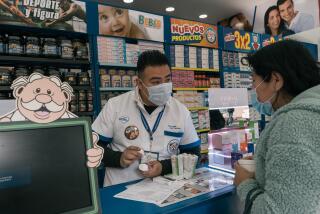Cuban Clinics Winning Foreign Patients : Unique Cuban Skin Treatment Attracting Foreign Patients--and Hard Currency
- Share via
HAVANA — A unique Cuban treatment for skin disease is luring thousands of patients to Havana as Cuba tries to establish itself as a top medical center for the developing world.
Already claiming to have one of the Third World’s most advanced medical systems, Cuba is exploring ways to use this expertise to earn vitally needed hard currency amid its worst foreign exchange shortage since the 1959 revolution.
To help turn medical advances into monetary dividends, the government established Servimex as a subsidiary of the Cubanacan holding company set up in 1987 to generate hard currency by developing tourism and joint ventures, a novelty in socialist Cuba.
Primarily through “health tourism” packages, Servimex is expected to earn $30 million this year, a jump from about $4 million in 1988, said its director, Dr. Ricardo Martinez Rojas.
“Some of our medical technology is very successful in developing countries. It was a matter of finding new outlets, and also to respond to demand,” he said.
Some of the potential foreign patients are those who suffer from vitiligo, a disorder that causes smooth white patches on the skin. It affects 40 million people worldwide.
A Cuban doctor, Carlos Miyares Cao, pioneered the use of “melagenina” ointment to treat the loss of pigmentation.
“People hear about our vitiligo treatment, they want to know more, they eventually visit us,” Martinez said.
“Nobody dies from vitiligo; therefore, it is little known. But it carries a lot of social rejection. People mistake it for leprosy or syphilis,” Miyares Cao told Reuters in an interview.
He began developing the treatment with melagenina--a placental extract in alcohol solution--in 1973 and began using it on a large scale in 1985. In 80% of the cases, Miyares Cao said, the treatment is successful.
He said a clinic in the Canary Islands offered vitiligo treatment with the “made in Cuba” medicine. Contacts have been established that could lead to manufacture of the ointment under license in Britain, Canada, India and Italy.
About 110 patients per month from 70 countries come to his small, modern clinic in the residential Miramar district.
Servimex travel packages that include room and board at a Havana hotel allow them to stay at least a week. This and the treatment--including computer analysis of how the cure is progressing--cost up to $250.
Patients come from as far away as Australia and India.
One Indian diplomat recounted how, in a country where most marriages are still arranged, misconceptions about vitiligo and the stigma it carries can cloud a young woman’s prospects.
Miyares Cao’s best known patient, Sri Lanka native Sarojini Ariyanayagam, 35, knows how it feels to be looked upon as “a freak.”
She came here from Britain in 1986 for three months, and returned a year ago to stay until the end of the treatment.
She describes hers as a “test case.” She has recovered skin color on 40% of her body; 85% of her skin had been affected.
Her photograph adorns Servimex brochures, and she works at the clinic in exchange for the treatment.
The vitiligo clinic is a stone’s throw from the Cira Garcia clinic, where Cubanacan offers a three-hour physical check-up for foreign visitors for $200, with a 10% discount for participants in international meetings and events.
Other sectors in which Cuba can use its potential as a “medical power” are cornea, kidney and bone marrow transplants and brain tissue transplants for Parkinson’s disease patients.
An assembly-line setting for the treatment of nearsightedness went into operation last year, only the second of its kind in the world after Moscow.
More to Read
Sign up for Essential California
The most important California stories and recommendations in your inbox every morning.
You may occasionally receive promotional content from the Los Angeles Times.













